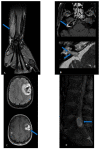Diagnosis and Treatment of Peripheral and Cranial Nerve Tumors with Expert Recommendations: An EUropean Network for RAre CANcers (EURACAN) Initiative
- PMID: 37046591
- PMCID: PMC10093509
- DOI: 10.3390/cancers15071930
Diagnosis and Treatment of Peripheral and Cranial Nerve Tumors with Expert Recommendations: An EUropean Network for RAre CANcers (EURACAN) Initiative
Abstract
The 2021 WHO classification of the CNS Tumors identifies as "Peripheral nerve sheath tumors" (PNST) some entities with specific clinical and anatomical characteristics, histological and molecular markers, imaging findings, and aggressiveness. The Task Force has reviewed the evidence of diagnostic and therapeutic interventions, which is particularly low due to the rarity, and drawn recommendations accordingly. Tumor diagnosis is primarily based on hematoxylin and eosin-stained sections and immunohistochemistry. Molecular analysis is not essential to establish the histological nature of these tumors, although genetic analyses on DNA extracted from PNST (neurofibromas/schwannomas) is required to diagnose mosaic forms of NF1 and SPS. MRI is the gold-standard to delineate the extension with respect to adjacent structures. Gross-total resection is the first choice, and can be curative in benign lesions; however, the extent of resection must be balanced with preservation of nerve functioning. Radiotherapy can be omitted in benign tumors after complete resection and in NF-related tumors, due to the theoretic risk of secondary malignancies in a tumor-suppressor syndrome. Systemic therapy should be considered in incomplete resected plexiform neurofibromas/MPNSTs. MEK inhibitor selumetinib can be used in NF1 children ≥2 years with inoperable/symptomatic plexiform neurofibromas, while anthracycline-based treatment is the first choice for unresectable/locally advanced/metastatic MPNST. Clinical trials on other MEK1-2 inhibitors alone or in combination with mTOR inhibitors are under investigation in plexiform neurofibromas and MPNST, respectively.
Keywords: MEK inhibitors; cauda equine neuroendocrine tumor; hybrid nerve sheath tumor; mTOR inhibitors; malignant peripheral nerve sheath tumor; neurofibroma; perineurioma; plexiform neurofibroma; schwannoma.
Conflict of interest statement
The authors declare no conflict of interest.
Figures

References
-
- Louis D.N., Perry A., Wesseling P., Brat D.J., Cree I.A., Figarella-Branger D., Hawkins C., Ng H.K., Pfister S.M., Reifenberger G., et al. The 2021 WHO Classification of Tumors of the Central Nervous System: A summary. Neuro-Oncology. 2021;23:1231–1251. doi: 10.1093/neuonc/noab106. - DOI - PMC - PubMed
-
- The WHO Classification of Tumours Editorial Board . WHO Classification of Tumours Soft Tissue and Bone Tumours. 5th ed. IARC Press; Lyon, France: 2020.
-
- Brainin M., Barnes M., Baron J.C., Gilhus N.E., Hughes R., Selmaj K., Waldemar G., Guideline Standards Subcommittee of the EFNS Scientific Committee Guidance for the preparation of neurological management guidelines by EFNS scientific task forces—Revised recommendations 2004. Eur. J. Neurol. 2004;11:577–581. doi: 10.1111/j.1468-1331.2004.00867.x. - DOI - PubMed
Publication types
LinkOut - more resources
Full Text Sources
Research Materials
Miscellaneous

